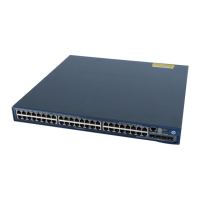95
NOTE:
Depending on the switch models, HP devices support BPDU tunneling for the following protocols:
Cisco Discovery Protocol (CDP)
Device Link Detection Protocol (DLDP)
Ethernet Operation, Administration and Maintenance (EOAM)
GARP VLAN Registration Protocol (GVRP)
HW Group Management Protocol (HGMP)
Link Aggregation Control Protocol (LACP)
Link Layer Discovery Protocol (LLDP)
Port Aggregation Protocol (PAGP)
Per VLAN Spanning Tree (PVST)
Spanning tree protocol (STP)
Uni-directional Link Direction (UDLD)
VLAN Trunking Protocol (VTP)
BPDU tunneling implementation
The BPDU tunneling implementations for different protocols are all similar. This section uses the Spanning
Tree Protocol (STP) as an example to describe how to implement BPDU tunneling.
NOTE:
This document uses the term
STP
in a broad sense. It includes STP, RSTP, and MSTP.
STP calculates the topology of a network by transmitting BPDUs among devices in the network. For more
information, see the chapter ―MSTP configuration.‖
To avoid loops in your network, you can enable STP on your devices. When the topology changes at one
side of the customer network, devices at that side of the customer network send BPDUs to devices on the
other side of the customer network to ensure consistent spanning tree calculation in the entire customer
network. However, because BPDUs are Layer 2 multicast frames, all STP-enabled devices, both in the
customer network and in the service provider network, can receive and process these BPDUs. As a result,
neither the service provider network nor the customer network can correctly calculate its independent
spanning tree.
BPDU tunneling allows each network to calculate an independent spanning tree with STP.
BPDU tunneling delivers the following benefits:
BPDUs can be transparently transmitted. BPDUs of the same customer network can be broadcast in a
specific VLAN across the service provider network, so that the geographically dispersed networks of
the same customer can implement consistent spanning tree calculation across the service provider
network.
BPDUs of different customer networks can be confined within different VLANs for transmission on the
service provider network. This enables each customer network to perform independent spanning tree
calculation.

